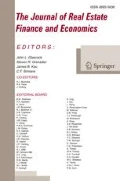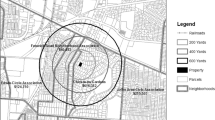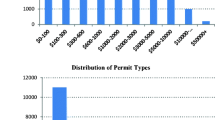Abstract
The foreclosure crisis in the U.S. has resulted in a large number of residential REOs. These properties have been found to reduce the value of nearby homes. An unresolved issue is whether these negative spillover effects disappear after the REO is sold. We hypothesize that these effects are greater if the REO is purchased by an investor in comparison to an owner–occupant. In this paper we report the results from estimating the spillover effects of both current and ex–REOs, where the latter are divided into those possessed by owner–occupants and those possessed by investors. The results lend considerable support to our hypothesis.
Similar content being viewed by others
Notes
REO or Real Estate Owned is a class of property owned by a lender—typically a bank, government agency, or government loan insurer—after an unsuccessful sale at a foreclosure auction.
Wall Street Journal, Market Watch, February 28, 2013, “Foreclosure Sales and Short Sales Account for 43 % of U.S. Residential Sales in 2012 According to RealtyTrac,” www.marketwatch.com accessed on March 1, 2013.
CoreLogic, January 02, 2013, “CoreLogic Reports Shadow Inventory Continues Decline in October 2012,” www.corelogic.com accessed on March 1, 2013. CoreLogic estimates the pending supply of REOs for sale (aka the “shadow inventory”) by calculating the number of properties that are seriously delinquent, in foreclosure and held as REO by mortgage servicers but not currently listed on multiple listing services.
It should be noted that the finding in the existing literature that small investors purchase most REO properties could possibly be an artifact of coding error. The identification of investors in these papers relies on string matching to flag investor purchases and the number of properties that have been purchased by an investor. There are a number of limitations to this approach. First, properties can be held under different corporate names even if they are, for all intents and purposes, owned by the same entity. Second, the buyer and seller fields in transaction data are not generally standardized, so a person’s name may occur in several different formats within the database. For instance, if exact string matching is used, “John Doe,” “John A Doe,” and “John Do” will be three distinct buyers, and none of the properties are treated as investor-purchased. Alternatively, consider a case where a real estate investment group buys 50 properties: 5 of the properties are coded as being owned by “Realty Invest LLC,” 4 are coded as being owned by “Realty Investments LLC,” and 91 are coded as “Realty Investments." In this case, instead of identifying the fact that the properties are all owned by one large investor, an exact string matching algorithm would identify 2 small investors and one large investor as the purchasers of the REOs.
DataQuick classifies a sale as a short sale if the sales price is more than 5 % less than the estimated total loan balance at the time of the sale.
In Florida, after a lender files suit against a borrower for defaulting on a note, if the default is not cured, the obligor’s property is put up for sale at a public auction. At this auction, the lender is given a credit at the auction equal to the amount of the final judgment handed down by the court. A property then enters REO status if there is no other party that outbids the lender; such a situation will generally be categorized as a type–(1) transaction under the typology above. However, after reviewing a large number of the documents underlying the distressed sale field, we identified that in a non–trivial number of cases, type–(2) and type–(3) transactions also represented an entry into the REO stock, which is why we include such transactions in the universe of REO starts. Experimentation with other REO–start classification systems (e.g., using only type–(1) observations) revealed that our empirical results are largely insensitive to the inclusion of type–(2) and type–(3) REO starts in the REO stock; such a finding is consistent with a high repossession rate conditional on a property being put up for auction. For more on the foreclosure process in Florida, see: http://www.realtytrac.com/foreclosure-laws/florida-foreclosure-laws.asp
The 3–year limitation is imposed to guard against cases in which DataQuick’s distressed sale algorithm identifies an REO start but fails to identify the REO exit. In a small number of cases, a sale that is categorized as non–distressed occurs within the 3–year REO start window. In these cases, this non–distressed sale is coded as an REO exit.
It should be noted that our REO stock measure does not include properties for which foreclosure proceedings have commenced but have not yet gone to auction. Although such properties are certainly distressed, we have not included them in our stock measure because our data do not allow us to identify distress before the property is transferred at the foreclosure auction.
Models estimated with neighborhood–specific trend terms yielded similar results to those reported here.
At the suggestion of an anonymous referee, we also conducted two unreported robustness checks. First, we re-estimated all of the hedonic models using a sample where foreclosure sales and short sales were excluded. The coefficients on the hedonic parameters estimated using this subsample without distressed sales are very similar to those reported here. In the second robustness check, we stratified the sample in each county by tenure rate (i.e., the percentage of single-family homes that were owner-occupied) and re-estimated the models on each sub-sample. Specifically, for each county in our sample, we calculated the owner occupancy rate at the time of sale within 3000 ft of the transacting property; the median value of the homeownership rate was then used to partition the sample into low-homeownership (below-median homeownership rate) and high-homeownership (above-median homeownership rate) samples. For each county, separate regressions were then run for each of the subsamples. Comparing the coefficients across the different neighborhood types, the magnitude on the innermost REO term was generally slightly larger in low- as compared to high-homeownership neighborhoods. There did not appear to be a clear pattern in the differences in the coefficient sizes across neighborhoods for the other variables. Within each of the county-tenure rate subsamples, the results from the main analysis described in the text held. Namely, it was generally the case that REOs that were sold to owner-occupants produced smaller spillovers than properties in REO status, non-homesteaded ex-REO properties produced larger spillovers than homesteaded ex-REO properties, and the spillovers associated with non-homesteaded ex-REO properties declined with the amount of time since exiting from REO status.
The results obtained from using the square root model are nearly identical to those obtained from the levels model and are therefore not reported.
The standard deviation is computed separately for each ring within each county.
References
Anenberg, E., & Kung, E. (2012). Estimates of the size and source of price declines due to nearby foreclosures. Finance and Economics Discussion Series, Divisions of Research and Statistics and Monetary Affairs, Federal Reserve Board, Washington, D.C. Working Paper Number 2012–84.
Campbell, J., Giglio, S., & Pathak, P. (2011). Forced sales and house prices. The American Economic Review, 101(5), 2108–2131.
Coulson, E., & and Li, H. (2012). Measuring the external benefits of homeownership. Unpublished manuscript.
Daneshvary, N., & Clauretie, T. (2012). Toxic neighbors: foreclosures and short–sales spillover effects from the current housing–market crash. Economic Inquiry, 50(1), 217–231.
Ellen, I., Madar, J., & Weselcouch, C. (2012). What’s really happening to the REO stock? An analysis of three cities: New York, Atlanta, and Miami. Unpublished manuscript.
Follain, J., & Malpezzi, S. (1979). Dissecting housing value and rent: Estimates of hedonic indexes for thirty-nine large SMSAs. Washington, DC: The Urban Institute.
Galster, G. (1983). Empirical evidence on cross-tenure differences in house maintenance and conditions. Land Economics, 59, 107–113.
Gatzlaff, D., Green, R., & Ling, D. (1998). Cross-tenure differences in home maintenance and appreciation. Land Economics, 74, 328–342.
Harding, J., Miceli, T., & Sirmans, C. F. (2000). Do owners take better care of their housing than renters? Real Estate Economics, 28, 663–681.
Harding, J., Rosenblatt, E., & Yao, V. (2009). The contagion effect of foreclosed properties. Journal of Urban Economics, 66(3), 164–178.
Ihlanfeldt, K., & Mayock, T. (2010). Panel data estimates of the effects of different types of crime on housing prices. Regional Science and Urban Economics, 40(2–3), 161–172.
Immergluck, D. (2012a). Distressed and dumped: market dynamics of low–value, foreclosed properties during the advent of the federal neighborhood stabilization program. Journal of Planning Education and Research, 32(1), 48–61.
Immergluck, D. (2012b). An analysis of the sales of foreclosed homes and subsequent resales in Fulton County, Georgia. Unpublished manuscript.
Immergluck, D., & Smith, G. (2006). The external costs of foreclosure: the impact of single–family mortgage foreclosures on property values. Housing Policy Debate, 17(1), 57–79.
Kain, J., & Quigley, J. (1970). Measuring the value of housing quality. Journal of the American Statistical Association, 65(330), 532–548.
Leigh, W. (1979). The estimation of tenure-specific depreciation/replacement rates using housing quantity measures for the U.S., 1950–1970. The Quarterly Review of Economics and Business, 19(1), 49–59.
Leonard, T., & Murdoch, J. (2009). The neighborhood effects of foreclosure. Journal of Geographical Systems, 11(4), 317–332.
Lin, Z., Rosenblatt, E., & Yao, V. (2009). Spillover effects of foreclosures on neighborhood property values. Journal of Real Estate Finance and Economics, 38(4), 387–407.
Mikelbank, B. (2008). Spatial analysis of the impact of vacant, abandoned, and foreclosed properties. Federal Reserve Bank of Cleveland Office of Community Affairs Working Paper.
Rogers, W. (2010). Declining foreclosure neighborhood effects over time. Housing Policy Debate, 20(4), 687–706.
Rogers, W., & Winter, W. (2009). The impact of foreclosures on neighboring housing sales. Journal of Real Estate Research, 31(4), 455–479.
Schuetz, J., Been, V., & Ellen, I. (2008). Neighborhood effects of concentrated mortgage foreclosures. Journal of Housing Economics, 17(4), 306–319.
Shilling, J., Sirmans, C. F., & Dombrow, J. (1991). Measuring depreciation in single-family rental and owner-occupied housing. Journal of Housing Economics, 1, 368–383.
Wassmer, R. (2011). The recent pervasive external effects of residential home foreclosure. Housing Policy Debate, 21(2), 247–265.
Weston, R. (1972). The quality of housing in the United States, 1929–1970. Ph.D. thesis, Harvard University.
Acknowledgments
The authors thank Kelley Pace, two anonymous referees, and participants in the 2013 FSU-UF Critical Issues in Real Estate Symposium for helpful comments. The views expressed in this paper are those of the authors and do not necessarily reflect those of the Office of the Comptroller of the Currency or the U.S. Department of the Treasury.
Author information
Authors and Affiliations
Corresponding author
Appendix
Appendix
Rights and permissions
About this article
Cite this article
Ihlanfeldt, K., Mayock, T. The Impact of REO Sales on Neighborhoods and Their Residents. J Real Estate Finan Econ 53, 282–324 (2016). https://doi.org/10.1007/s11146-014-9465-0
Published:
Issue Date:
DOI: https://doi.org/10.1007/s11146-014-9465-0




